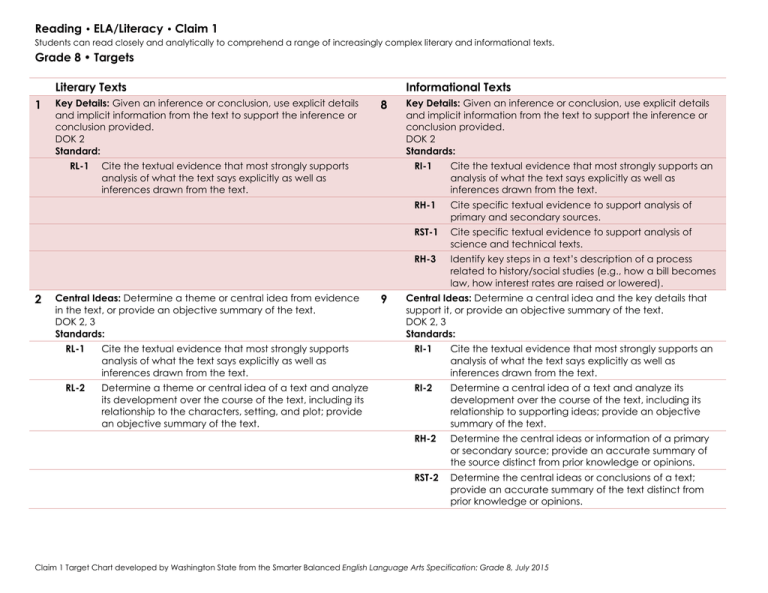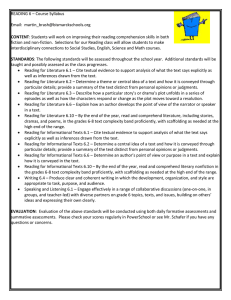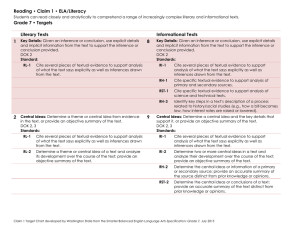ELA Grade 8 Claim 1 Targets (long version)
advertisement

Reading • ELA/Literacy • Claim 1 Students can read closely and analytically to comprehend a range of increasingly complex literary and informational texts. Grade 8 • Targets Literary Texts 1 Key Details: Given an inference or conclusion, use explicit details and implicit information from the text to support the inference or conclusion provided. DOK 2 Standard: RL-1 2 Informational Texts 8 Cite the textual evidence that most strongly supports analysis of what the text says explicitly as well as inferences drawn from the text. Central Ideas: Determine a theme or central idea from evidence in the text, or provide an objective summary of the text. DOK 2, 3 Standards: 9 Key Details: Given an inference or conclusion, use explicit details and implicit information from the text to support the inference or conclusion provided. DOK 2 Standards: RI-1 Cite the textual evidence that most strongly supports an analysis of what the text says explicitly as well as inferences drawn from the text. RH-1 Cite specific textual evidence to support analysis of primary and secondary sources. RST-1 Cite specific textual evidence to support analysis of science and technical texts. RH-3 Identify key steps in a text’s description of a process related to history/social studies (e.g., how a bill becomes law, how interest rates are raised or lowered). Central Ideas: Determine a central idea and the key details that support it, or provide an objective summary of the text. DOK 2, 3 Standards: RL-1 Cite the textual evidence that most strongly supports analysis of what the text says explicitly as well as inferences drawn from the text. RI-1 Cite the textual evidence that most strongly supports an analysis of what the text says explicitly as well as inferences drawn from the text. RL-2 Determine a theme or central idea of a text and analyze its development over the course of the text, including its relationship to the characters, setting, and plot; provide an objective summary of the text. RI-2 Determine a central idea of a text and analyze its development over the course of the text, including its relationship to supporting ideas; provide an objective summary of the text. RH-2 Determine the central ideas or information of a primary or secondary source; provide an accurate summary of the source distinct from prior knowledge or opinions. RST-2 Determine the central ideas or conclusions of a text; provide an accurate summary of the text distinct from prior knowledge or opinions. Claim 1 Target Chart developed by Washington State from the Smarter Balanced English Language Arts Specification: Grade 8, July 2015 Reading • ELA/Literacy • Claim 1 Students can read closely and analytically to comprehend a range of increasingly complex literary and informational texts. Grade 8 • Targets 3 Word Meanings: Determine intended or precise meanings of words, including academic/tier 2 words, domain-specific (tier 3) words, and words with multiple meanings, based on context, word relationships (e.g., connotations, denotations), word structure (e.g., common Greek or Latin roots, affixes), or use of reference materials (e.g., dictionary), with primary focus on determining meaning based on context and the academic (tier 2) vocabulary common to complex texts in all disciplines. DOK 1, 2 Standards: 10 Word Meanings: Determine intended meanings of words including academic/tier 2 words, domain-specific (tier 3) words, and words with multiple meanings, based on context, word relationships (e.g., connotation, denotation), word structure (e.g., common Greek or Latin roots, affixes), or use of reference materials (e.g., dictionary), with primary focus on determining meaning based on context and the academic (tier 2) vocabulary common to complex texts in all disciplines. DOK 1, 2 Standards: RL-1 Cite the textual evidence that most strongly supports analysis of what the text says explicitly as well as inferences drawn from the text. RI-1 Cite the textual evidence that most strongly supports an analysis of what the text says explicitly as well as inferences drawn from the text. RL-4 Determine the meaning of words and phrases as they are used in a text, including figurative and connotative meanings; analyze the impact of specific word choices on meaning and tone, including analogies or allusions to other texts. RI-4 Determine the meaning of words and phrases as they are used in a text, including figurative, connotative, and technical meanings; analyze the impact of specific word choices on meaning and tone, including analogies or allusions to other texts. L-4 Determine or clarify the meaning of unknown and multiple-meaning words and phrases based on grade 8 reading and content, choosing flexibly from a range of strategies. RH-4 Determine the meaning of words and phrases as they are used in a text, including vocabulary specific to domains related to history/social studies. L-4a Use context (e.g., the overall meaning of a sentence or paragraph; a word’s position or function in a sentence) as a clue to the meaning of a word or phrase. RST-4 Determine the meaning of symbols, key terms, and other domain-specific words and phrases as they are used in a specific scientific or technical context relevant to grades 6–8 texts and topics. L-4b Use common, grade-appropriate Greek or Latin affixes and roots as clues to the meaning of a word (e.g., precede, recede, secede). L-4 Determine or clarify the meaning of unknown and multiple-meaning words and phrases based on grade 8 reading and content, choosing flexibly from a range of strategies. L-4c Consult general and specialized reference materials (e.g., dictionaries, glossaries, thesauruses), both print and digital, to find the pronunciation of a word or determine or clarify its precise meaning or its part of speech. L4-a Use context (e.g., the overall meaning of a sentence or paragraph; a word’s position or function in a sentence) as a clue to the meaning of a word or phrase. L-4d Verify the preliminary determination of the meaning of a word or phrase (e.g., by checking the inferred meaning in context or in a dictionary). L-4b Use common, grade-appropriate Greek or Latin affixes and roots as clues to the meaning of a word (e.g., precede, recede, secede). Claim 1 Target Chart developed by Washington State from the Smarter Balanced English Language Arts Specification: Grade 8, July 2015 Reading • ELA/Literacy • Claim 1 Students can read closely and analytically to comprehend a range of increasingly complex literary and informational texts. Grade 8 • Targets 4 L-5b Use the relationship between particular words to better understand each of the words. L-4c Consult general and specialized reference materials (e.g., dictionaries, glossaries, thesauruses), both print and digital, to find the pronunciation of a word or determine or clarify its precise meaning or its part of speech. L-5c Distinguish among the connotations (associations) of words with similar denotations (definitions) (e.g., bullheaded, willful, firm, persistent, resolute). L-4d Verify the preliminary determination of the meaning of a word or phrase (e.g., by checking the inferred meaning in context or in a dictionary). L-6 Acquire and use accurately grade-appropriate general academic and domain-specific words and phrases; gather vocabulary knowledge when considering a word or phrase important to comprehension or expression. L-5b Use the relationship between particular words to better understand each of the words. L-5c Distinguish among the connotations (associations) of words with similar denotations (definitions) (e.g., bullheaded, willful, firm, persistent, resolute). L-6 Acquire and use accurately grade-appropriate general academic and domain-specific words and phrases; gather vocabulary knowledge when considering a word or phrase important to comprehension or expression Reasoning & Evidence: Make an inference or draw a conclusion about a text OR make inferences or draw conclusions in order to compare texts (e.g., dialogue, plot, character development, points of view, themes) and use supporting evidence as justification/explanation. DOK 3, 4 Standards: 11 Reasoning & Evidence: Make an inference or draw a conclusion about a text OR make inferences or draw conclusions in order to compare texts (e.g., connections or distinctions between individuals, ideas, or events; author’s point of view/purpose/conflicting viewpoints; evaluate multiple sources of information presented in different media or formats; delineate and evaluate the argument and specific claims) and use supporting evidence as justification/explanation. DOK 3, 4 Standards: RL-1 Cite the textual evidence that most strongly supports analysis of what the text says explicitly as well as inferences drawn from the text. RI-1 Cite the textual evidence that most strongly supports an analysis of what the text says explicitly as well as inferences drawn from the text. RL-3 Analyze how particular lines of dialogue or incidents in a story or drama propel the action, reveal aspects of a character, or provoke a decision. RI-3 Analyze how a text makes connections among and distinctions between individuals, ideas, or events (e.g., through comparisons, analogies, or categories). Claim 1 Target Chart developed by Washington State from the Smarter Balanced English Language Arts Specification: Grade 8, July 2015 Reading • ELA/Literacy • Claim 1 Students can read closely and analytically to comprehend a range of increasingly complex literary and informational texts. Grade 8 • Targets 5 RL-6 Analyze how differences in the points of view of the characters and the audience or reader (e.g., created through the use of dramatic irony) create such effects as suspense or humor. RI-6 Determine an author’s point of view or purpose in a text and analyze how the author acknowledges and responds to conflicting evidence or viewpoints. RL-9 Analyze how a modern work of fiction draws on themes, patterns of events, or character types from myths, traditional stories, or religious works such as the Bible, including describing how the material is rendered new. RH-6 Identify aspects of a text that reveal an author’s point of view or purpose (e.g., loaded language, inclusion or avoidance of particular facts). RST-6 Analyze the author’s purpose in providing an explanation, describing a procedure, or discussing an experiment in a text, identifying important issues that remain unresolved. RI-7 Evaluate the advantages and disadvantages of using different mediums (e.g., print or digital text, video, multimedia) to present a particular topic or idea. RI-8 Delineate and evaluate the argument and specific claims in a text, assessing whether the reasoning is sound and the evidence is relevant and sufficient; recognize when irrelevant evidence is introduced. RH-8 Distinguish among fact, opinion, and reasoned judgment in a text. RST-8 Distinguish among facts, reasoned judgment based on research findings, and speculation in a text. RI-9 Analyze a case in which two or more texts provide conflicting information on the same topic and identify where the texts disagree on matters of fact or interpretation. Analysis Within Or Across Texts: Analyze relationships among literary elements (e.g., dialogue, advancing action, character actions/interactions) within or across texts or analyze differences in point of view within or across texts. DOK 3, 4 Standards: RL-1 Cite the textual evidence that most strongly supports analysis of what the text says explicitly as well as inferences drawn from the text. 12 Analysis Within Or Across Texts: Analyze or compare connections within or across texts (e.g. individuals, ideas, or events), or how information within or across texts reveals author's point of view or purpose. DOK 3, 4 Standards: RI-1 Cite the textual evidence that most strongly supports an analysis of what the text says explicitly as well as inferences drawn from the text. Claim 1 Target Chart developed by Washington State from the Smarter Balanced English Language Arts Specification: Grade 8, July 2015 Reading • ELA/Literacy • Claim 1 Students can read closely and analytically to comprehend a range of increasingly complex literary and informational texts. Grade 8 • Targets 6 RL-3 Analyze how particular lines of dialogue or incidents in a story or drama propel the action, reveal aspects of a character, or provoke a decision. RI-3 Analyze how a text makes connections among and distinctions between individuals, ideas, or events (e.g., through comparisons, analogies, or categories). RL-6 Analyze how differences in the points of view of the characters and the audience or reader (e.g., created through the use of dramatic irony) create such effects as suspense or humor. RI-6 Determine an author’s point of view or purpose in a text and analyze how the author acknowledges and responds to conflicting evidence or viewpoints. Text Structures & Features: Analyze text structures and the impact of those choices on meaning or presentation. DOK 2, DOK 3 13 Standards: 7 Text Structures & Features: knowledge of text structures (e.g. organization of a paragraph) or text features to analyze the impact (advantages/disadvantages) of those choices on meaning or presentation. DOK 2, 3 Standards: RL-1 Cite the textual evidence that most strongly supports analysis of what the text says explicitly as well as inferences drawn from the text. RI-1 Cite the textual evidence that most strongly supports an analysis of what the text says explicitly as well as inferences drawn from the text. RL-5 Compare and contrast the structure of two or more texts and analyze how the differing structure of each text contributes to its meaning and style. RI-5 Analyze in detail the structure of a specific paragraph in a text, including the role of particular sentences in developing and refining a key concept. RH-5 Describe how a text presents information (e.g., sequentially, comparatively, causally). RST-5 Analyze how the text structures information or ideas into categories or hierarchies, demonstrating understanding of the information or ideas. RI-7 Evaluate the advantages and disadvantages of using different mediums (e.g., print or digital text, video, multimedia) to present a particular topic or idea. Language Use: Interpret and analyze figurative language use (e.g., figurative, connotative meanings) or demonstrate understanding of nuances in word meanings used in context and the impact of those word choices on meaning and tone. DOK 3 Standards: 14 Language Use: Interpret understanding of figurative language, word relationships, nuances of words and phrases, or figures of speech (e.g., verbal irony, puns) used in context and the impact of those word choices on meaning. DOK 3 Standards: Claim 1 Target Chart developed by Washington State from the Smarter Balanced English Language Arts Specification: Grade 8, July 2015 Reading • ELA/Literacy • Claim 1 Students can read closely and analytically to comprehend a range of increasingly complex literary and informational texts. Grade 8 • Targets RL-1 Cite the textual evidence that most strongly supports an analysis of what the text says explicitly as well as inferences drawn from the text. RI-1 Cite the textual evidence that most strongly supports an analysis of what the text says explicitly as well as inferences drawn from the text. RL-4 Determine the meaning of words and phrases as they are used in a text, including figurative and connotative meanings; analyze the impact of specific word choices on meaning and tone, including analogies or allusions to other texts. L-5 Demonstrate understanding of figurative language, word relationships, and nuances in word meanings. L-5 Demonstrate understanding of figurative language, word relationships, and nuances in word meanings. L-5a Interpret figures of speech (e.g., verbal irony, puns) in context. L-5a Interpret figures of speech (e.g., verbal irony, puns) in context. Claim 1 Target Chart developed by Washington State from the Smarter Balanced English Language Arts Specification: Grade 8, July 2015





